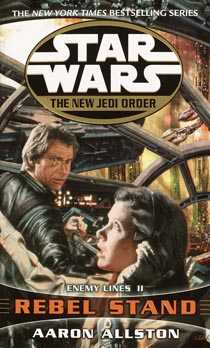Aaron Allston is best known for his Wraith Squadron novels, but his two “New Jedi Order” novels – the “Enemy Lines” duology – are sneaky good, too. They don’t make as strong of an impression as other his “Star Wars” novels because they lack a main character or even group of characters. Indeed, “Enemy Lines II: Rebel Stand” (2002) is a bit all over the place even when compared to “Rebel Dream” – which centered on a battle at Borleias – but it still offers some great little subplots.
My favorite is Han and Leia’s undercover mission to set up rebel cells. As established in “Rebel Dream,” people who want to fight back against the Yuuzhan Vong are going to have to do so outside the structure of the New Republic, as the Advisory Council has sold out the military. Meanwhile, many planetary governments have adopted policies of appeasement with the Vong or their proxies, the Peace Brigade. While some military veterans – bringing some materiel with them – are fighting at Borleias, any long-term success will require resistance cells.
Intriguingly, this means Han and Leia must rig an election on the planet Vannix. The Solos see that the people are favoring the appeasement candidate, Addath, but also that she doesn’t truly favor appeasement, only power. As Allston writes on page 125:
Addath was no fool. She could analyze the Yuuzhan Vong’s relationship with ‘allied’ worlds as well as anyone else. Addath simply could not give up the reins of power, and would hold them in clenched hands, whatever the cost. Since military opposition to the Yuuzhan Vong meant handing too much power to others, she was willing to steer this world into eventual oblivion … just so long as she was in control until that final moment.
Both the New Republic and Vannix specifically have systems where the political class and the military class are somewhat separate, a contrast to the modern U.S., where they are inextricably linked. Both systems are problematic, but it in the “NJO,” the slight separation between the classes allows for the military to break free and fight for just causes rather than being a pawn of politicians. It’s an interesting alternative approach, if nothing else.
The second most intriguing element of “Rebel Stand” is a good old fashioned mystery on Coruscant. I had feared the journey through the Vongformed capital planet by Luke, Mara, Tahiri, Danni and wisecracking Wraiths Face and Kell would be a bleak survival yarn. But it is spiced up by the introduction of “Lord Nyax,” named after a children’s horror monster in the “Star Wars” universe. As it turns out, this powerful Force user who is terrorizing Coruscanti survivors and Vong alike is Irek Ismaren, last seen in “Children of the Jedi.” In a secret former Imperial lab, Roganda Ismaren had used mad science to enhance her son’s Force abilities and turn him into this monster. Although I had completely forgotten about this character, it’s a cool callback by Allston, and a prime example of the fun of the massive EU continuity.

Allston also held my attention with more of the Jag-Jaina romance; some surprising humanizing of R2-D2 as we actually see the droid “speak” in Basic via Leia’s datapad; some more exploits for Tam Elgrin, the unsung holocam operator who unfortunately bows out of the saga here; and the conclusion of the arc of turncoat Viqi Shesh, who provides a human POV to the Vong’s actions on Coruscant, and ultimately commits suicide rather than let either side kill her.
“Rebel Stand” misfires in a few areas, so I have to rank it a bit below the previous entry, and the big problem is the continuing military action around Borleias. The X-wing-versus-coralskipper dogfights start to drag a bit, especially since they are just a way to tread water until the conclusion. Allston makes it clear that the Vong will take Borleias back – it’s just a matter of time – so it’s not entirely clear why our heroes are still hanging around. It’s also odd that the Millennium Falcon can go off on a mission and then safely return to Borleias – which has now started to feel like home to Leia – yet at the same time we’re told that the planet is not safe: the Vong bombard the rebel base from the air and are poised to conquer it.
I felt like the fake-out of Operation Starlancer (a multipronged super energy weapon, a working version of which was seen in “The Force Awakens”) was revealed in the last book, but it’s still a plot point here for some reason. And there’s a big, conclusive bit of trickery with the Super Star Destroyer Lusankya that didn’t quite make sense to me or hold my attention. Our heroes are slowly scuttling the ship before using it as a massive ramming weapon, but how would the Vong not notice all the personnel and weaponry moving off of it?
While there is arguably too much going on in this 366-page paperback, the majority of it is fun to read, and it’s not nearly as dark as most of the “NJO” — or should I say, the reputation of the “NJO.” The big reason for that reputation is that the aggressively character-centered pieces, like the upcoming Jacen Solo joint “Traitor,” tend to be darker. But for now, Allston reminds us that the fun and light part of “Star Wars” is still alive and well.

